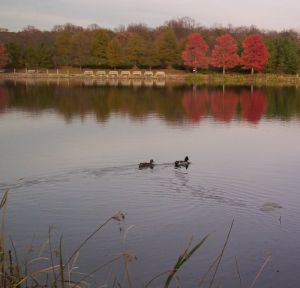

Howdy, pilgrim! You're in volume 0.65 of the ^zhurnal — see ZhurnalyWiki on zhurnaly.com for a parallel "live" Wiki edition; see Zhurnal and Zhurnaly for quick clues as to what this is all about. Briefly, it's the journal of ^z = Mark Zimmermann ... previous volume = 0.64 ... complete list at bottom of page ... send comments & suggestions to "z(at)his(dot)com" ... tnx!
Today as part of continuing work on the house, RadRob and I moved a cabinet from the basement to the kitchen. On top of it as per Paulette's guidance we placed a mini-refrigerator, and on top of that a microwave. I suggested that perhaps we should put a toaster-oven on the microwave, and that a bread machine could conveniently go on top of the toaster-oven.
And that in turn brought to mind an ancient cosmological theory: that the Earth rides on the back of a gigantic elephant, which stands in turn upon a huge tortoise. What holds that creature up? Some say another tortoise, which stands upon another, and yet another, making an infinite regression.
My new model of the universe: It's appliances, all the way down! (^_^)
(cf. ManyWorldsDemystified (1999-10-24), ...)
- Saturday, January 19, 2008 at 17:05:10 (EST)
In Chapter VI ("On the Road") of Running Through the Wall: A Guide for the Serious Runner Raymond Bridge observes:
... The whole idea of training is to stress the body, breaking down some tissue and pushing your muscles to work hard so that they will be stimulated to grow back stronger, better coordinated, and able to deal with still greater stress. This is a cycle like the tides, not a linear progression like climbing a ladder. There are two equally essential parts to the whole, and if either is removed training won't take place. The first part is the stress, which is essential as a stimulus to the body. The second part is the recuperation stage, during which the actual rebuilding takes place. If you remove the stress, the body won't bother to get stronger. If you remove the rest phase, it won't be able to. Though there are many cycles operating at different rates in the body, it has been shown time and again that rebuilding after a hard workout normally requires more than a day. This means that hard workouts should be alternated with easy days during which the body actually strengthens itself.
(cf. Bill Bowerman's advice quoted in BabyGetsNewShoes (2006-09-05): "... That's all training is. Stress. Recover. Improve....")
- Thursday, January 17, 2008 at 21:10:43 (EST)
Physicist Frank Wilczek in his January 2008 Physics Today column talks about how Don Herbert, "Mr. Wizard" of 1950's and 60's TV fame, encouraged the children in his audience to think like scientists, and in many cases to grow up to be scientists. In contrast, Wilczek observes, "Other wizards are more famous." — even as they depict success without perserverance, analysis, and long-term study:
Harry Potter, and in a different way the "magic realism" genre, presents essentially an irrational world with less ironic detachment than Frank Baum's Oz series. In those worlds, curiosity gets no traction, for anything can happen, and what you discover today tells you little about what will happen tomorrow. Great power is distributed randomly and whimsically, not as the result of intellectual work. A tempting fantasy that is allied to the romantic concept of "genius." It has, in Bertrand Russell's memorable phraseology, "all the advantages of theft over honest labor." To the extent that these fictional conceptions are absorbed and internalized, they tend to legitimize intellectual passivity and wishful thinking.
(cf. HelpfulHomilies (2007-09-02), ...)
- Tuesday, January 15, 2008 at 21:38:31 (EST)
This year's Bull Run Run 50 miler has a new entry system. In brief and to oversimplify: applicants are each assigned an independent random number. When registration closes, if the race is oversubscribed then a random starting point is selected and a block of entrants are chosen from those whose assigned numbers lie in sequence above that starting point, wrapping around so there is no endpoint. (The actual system has all sorts of other complexities, but that's what it boils down to.)
It's a fair, reasonable way to give everyone a chance to get in while avoiding the train-wreck rush-to-register that has caused some race web sites to crash from traffic overloads. But the BRR lottery system raises a fascinating personal question for me, since I would like to do the race with a friend. We've both registered --- but what are the odds that we both can run? If entries were chosen at random then our chances would be independent, uncorrelated. In that case if each of us has a chance x of getting lucky (or unlucky, if you don't like running ultramarathons!) then the joint probability is simply the product of our individual odds: x * x.
But the Bull Run Run lottery system doesn't pick entrants independently --- it picks them in sequence. If my friend has a number close to mine, then our chances are positively correlated: if one of us gets in, then the other probably will too. If our numbers are far apart, then we're anticorrelated.
What's the result? Since I'm a bit mathematically obsessive I stayed up late last night thinking about it --- and now if you have insomnia, I have the answer for you! (^_^)
Assume random numbers are chosen on the unit interval, between 0 and 0.999..., with equal probability. Remember that everything wraps around, so immediately after 0.999... we come back to 0. Define d as the distance between my comrade's number and mine measured the short way; wraparound means that the long-way gap between us is 1 - d. Possible values of d range from 0 to 0.5, with 0.25 the average.
Let x be the fraction of all numbers chosen. If P(x,d) is the probability that both of us are selected, then:
0 for x < d
P(x,d) = x - d for d < x < 1 - d
2*x - 1 for x > 1 - d
So what does that really mean? Glad you asked! Imagine a hula hoop, a big ring. My friend and I are randomly assigned points around the circumference of the hoop. A snake starts to crawl around the hoop. What's the chance that the snake is simultaneously touching both of our points? There are three cases:
Start out with a tiny snake and let it grow. At first the snake's length makes no difference --- the chance of it touching both points is 0 when the snake is too short. Once the snake is long enough to bridge the shorter gap between the two points then the fraction of the time it touches both during its journey grows directly in proportion to the snake's length. But when the snake is long enough to bridge both gaps, then the fraction of time it touches both grows twice as fast --- it has two ways to overlap us.
Here's a chart of the odds (the rightmost column is for completely uncorrelated entries, picked independently):
| x \ d | 0.0 | 0.1 | 0.2 | 0.3 | 0.4 | 0.5 | random |
|---|---|---|---|---|---|---|---|
| 0.0 | 0.0 | 0.0 | 0.0 | 0.0 | 0.0 | 0.0 | 0.00 |
| 0.1 | 0.1 | 0.0 | 0.0 | 0.0 | 0.0 | 0.0 | 0.01 |
| 0.2 | 0.2 | 0.1 | 0.0 | 0.0 | 0.0 | 0.0 | 0.04 |
| 0.3 | 0.3 | 0.2 | 0.1 | 0.0 | 0.0 | 0.0 | 0.09 |
| 0.4 | 0.4 | 0.3 | 0.2 | 0.1 | 0.0 | 0.0 | 0.16 |
| 0.5 | 0.5 | 0.4 | 0.3 | 0.2 | 0.1 | 0.0 | 0.25 |
| 0.6 | 0.6 | 0.5 | 0.4 | 0.3 | 0.2 | 0.2 | 0.36 |
| 0.7 | 0.7 | 0.6 | 0.5 | 0.4 | 0.4 | 0.4 | 0.49 |
| 0.8 | 0.8 | 0.7 | 0.6 | 0.6 | 0.6 | 0.6 | 0.64 |
| 0.9 | 0.9 | 0.8 | 0.8 | 0.8 | 0.8 | 0.8 | 0.81 |
| 1.0 | 1.0 | 1.0 | 1.0 | 1.0 | 1.0 | 1.0 | 1.00 |
Will my friend and I both get to run Bull Run Run? Right now the gap d between us is about 0.2, and x is about 0.9, so our odds look good. But x is falling fast --- entries are still pouring in. Registration closes tomorrow at 9pm and we won't know the starting point for the block of successful entries until a week later. Even after that, there's a chance that many people will drop out, opening up more slots for us. So we have our fingers crossed ...
And thinking back, I remember seeing problems like this analyzed in Martin Gardner's much-beloved Scientific American "Mathematical Games" columns, ca. 1965 ...
(cf. BullRunRun2007 (2007-04-15), BullRunRun2007Photos (2007-04-17), ...)
- Monday, January 14, 2008 at 21:27:43 (EST)
Paint Branch Trail starts near College Park Airport, curls past Lake Artemesia, traverses one side of the University of Maryland campus, skirts soccer fields and a golf course and driving range, winds through a tornado-devastated zone, and terminates about 3.75 miles upstream near the intersection of US Route 1 and the Capital Beltway (I-95). (Click on the photos below to see an image/map of that location)
 | Ducks and other aquatic creatures frequent lovely Lake Artemesia; this view is from Paint Branch Trail on the southern side of the lake loop trail. |
| Paint Branch Trail begins at the end of Northeast Branch Trail and the starting point of Indian Creek Trail, just north of the College Park Airport. | 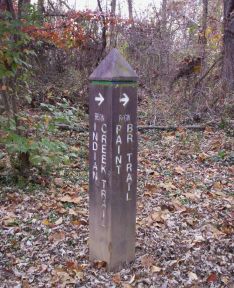 |
| The trail crawls through the woods, passes close to a pedestrian bridge leading to Paint Branch Parkway, and runs through Paint Branch Park toward busy US Route 1, aka Baltimore Avenue. | 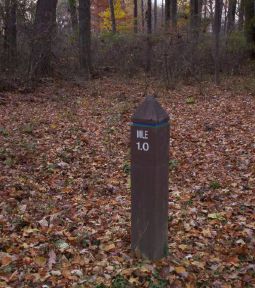 |
| As the trail zig-zags around the north end of the golf course it follows the edge of agricultural research fields and crosses multiple small bridges. | 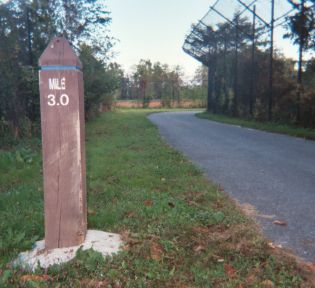 |
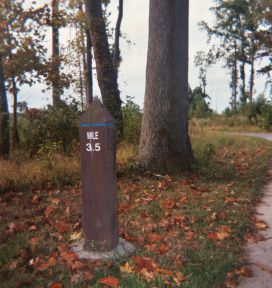 | Paint Branch Trail next passes through a section of Cherry Hill Neighborhood Park which was badly damaged by the tornado of 24 September 2001. |
| Paint Branch Trail continues north to cross Cherry Hill Road (danger!) and comes to an end just inside the Capital Beltway at Cherry Hill Road Park near tennis courts and shopping malls. | 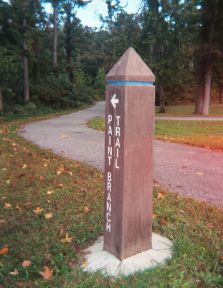 |
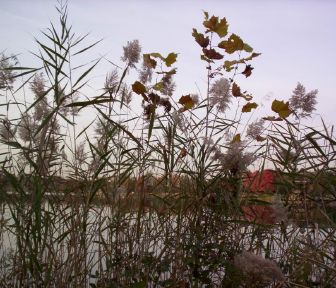 | Lake Artemesia in the autumn is surrounded by wildflowers and wetland foliage. This view is from Paint Branch Trail on the southern side of the lake loop trail. |
(Note: coordinates of mileposts along Paint Branch Trail have been adjusted to match Google Map imagery as of early 2008; for measured GPS coordinates, which may contain other errors, see DC Metro Area Trails: GPS Waypoints; cf. RockCreekTrail (31 May 2002), GoogleMapExperiments (11 Sep 2005), RockCreekTrailMiles0To4 (26 Sep 2005), RockCreekTrailMiles5To9 (16 Jan 2006), ...)
- Saturday, January 12, 2008 at 21:57:11 (EST)
In Chapter 28 of his autobiography (I. Asimov: A Memoir) Isaac Asimov reminisces about his friend and fellow science-fiction author Lester del Rey:
Lester is one of those people whom good luck has thrown my way. He is completely honest, a man of his word, and absolutely trustworthy. After all, one meets so many sleazeballs, so many people who lie and twist and whose word cannot be trusted, that one sometimes gets the sick feeling that life is a garbage pit in which people are the rotting banana peels. Yet one honest man refreshes the air fouled by a thousand devious rascals. For that reason I value Lester and the other honest men I have met in and out of science fiction.
There is a story in Jewish moralistic literature that God refrains from destroying this wicked, sinful world only for the sake of the few just men who can be found in it in every generation. Were I religious, I would believe this devoutly, and I can never be sufficiently grateful that so many just men have come my way, and that I have so rarely fallen into the hands of the wicked.
(cf. Isaac Asimov (28 Nov 2007), ...)
- Thursday, January 10, 2008 at 21:07:45 (EST)
Mundane personal anecdote: during my pre-dawn walk to the metro station for the past month I've often met a bicyclist blasting down the opposite side of the street toward me at 5:50am, plus or minus 1-2 minutes. (He's apparently as much a creature of habit and schedule as I am!) His white headlight is bright, but after he passes I've glanced back and noticed that the flashing red light on his helmet is totally obscured by his backpack, since he rides crouched low over his handlebars.
Automobiles speed along the same street, which narrows to one lane as it passes the graveyard. Visions began to pass through my head of the mystery bicycle man run down by a car that never sees him. But how to communicate a hazard with somebody you only encounter en passant for a few seconds every few days? I fretted about this for many mornings, and finally took to walking on the other side of the street.
The cyclist didn't appear several days in a row, but finally last week I saw him, gathered my wits, and waved frantically to flag him down. Oblivious, he didn't pause. So I shouted, "Can't see your taillight!" after him. It was all I had time to come up with. He reached back, I presume to check whether the switch was off or the battery dead. I figured that I'd have to keep trying.
But apparently my unknown nightrider figured out the problem, thank goodness. This week his flashing light is clipped low on his backpack where cars have a chance to spot it before it's too late. I can relax again, and imagine that I've saved a life ... until I see the old lady in her motorized wheelchair crawling along the same street, cars narrowing missing her as she refuses to use the sidewalk. I don't think she will listen to me ...
(cf. ParkwayDelay (28 Dec 2001), ...)
- Wednesday, January 09, 2008 at 19:09:59 (EST)
| Only a little has to go wrong for a lot to go wrong in an ultramarathon. |
... and sometimes one can recover, sometimes not.
The above aphorism was inspired by Verlyn Klinkenborg's column in the 6 Jan 2007 New York Times about life on a farm during a severe cold snap in mid-winter; as he says, "Only a little has to go wrong for a lot to go wrong in this weather." Likewise in an ultra ...
(cf. NewNickel (9 Mar 2005), WhatWeKnow (15 Aug 2006), FullMoonMetaphors (29 Oct 2007), ...)
- Tuesday, January 08, 2008 at 22:58:29 (EST)
Scott Aaronson's often-hilarious quantum-computing blog "Shtetl-Optimized" [1] hit another home run recently with "Ten Signs a Claimed Mathematical Breakthrough is Wrong". (Yeah, I love lists!) The short form of his rules:
Aaronson concludes with a deep truth about how work is really done in academia:
... if it passes all ten that still doesn't mean it's right. At some point, there might be nothing left to do except to roll up your sleeves, brew some coffee, and tell your graduate student to read the paper and report back to you.
- Monday, January 07, 2008 at 21:22:12 (EST)
As I read the first few pages of a recent article about marathon champion Joan Benoit Samuelson ("A Wicked Good Life", January 2008 Runner's World magazine) the realization slowly comes to me that it's written extraordinarily well. Only then do I flip back and discover the author is Kenny Moore. He does a superb job of profiling Samuelson, now 50 years old and still a lovely, amazing, ultra-high-energy person. I can only hope that the essay turns into a chapter of a book some day, like Moore's biography of Bill Bowerman. A representative snippet, as Moore visits Joan at her home in Maine:
On our first night together, Joan serves buttery beets, beans, and pungent salad greens, fresh from her garden. She is tanned and lean — leaner, it seems, than in her 20s, her great years when she won the two Boston marathons. Her fastest marathon, the American record until 2003, was the 2:21:21 she ran to defeat Norway's Ingrid Kristiansen in Chicago in 1985. Then she was a sprite, a waif in a Red Sox cap, and her strength the more astounding for it. Now her chin and nose are sharper. She's grown into the face of a great marathoner, and much more.
A few decades ago I had a similar experience when reading a startlingly-smooth essay in The New Yorker magazine, the 3 July 1978 issue. It was titled "Giving Good Weight" and focused on farmer's markets. Not a subject one might ordinarily find too gripping, but as the prose flowed past I came up for air and had to turn back to the title page, where I discovered who it was by: John McPhee.
In both cases, I should have known ...
(cf. SenseOfWhereYouAre (4 Jun 1999), InvisibleWriting (16 Dec 1999), DefensiveQuestions (12 May 2000), WorldTradeCenter (11 Sep 2001), IndianRiver (30 Jul 2004),, WithoutLimits (12 Feb 2005), BillBowerman (18 Feb 2006), LessonsOfTheMarathon (28 Aug 2006), RunningVersusTraining (22 Sep 2006), UncommonCarriers (23 Apr 2007), ...)
- Sunday, January 06, 2008 at 19:43:24 (EST)
As we jog together along the trail a few miles into the New Year's Day "Red Eye 50k" race I learn the Big Secret of running 100 miles from ultramarathon veteran Lou Jones:
| You just have to not quit! |
Notes on that pedestrian experience, and others, follow.
Sligo Creek + Northwest Branch Loop
24 Dec 2007 — 16+ miles (~13 min/mi) — The phone in my fanny pack rings and I discover that carrying two water bottles plus a GPS receiver doesn't leave many hands free to answer. It's Christina calling as I cross University Blvd, ca. mile 13 of my circuit. Our schedules don't mesh so we defer plans to walk and jog together, and for now just wish one another happy holidays.
Today's Christmas Eve expedition is far more pleasant than the "Hypotensive Bonk" of 17 Aug 2007 recorded in Pied Beauty, though it follows precisely the same route: from home via Forest Glen Rd to Sligo Creek Trail, then upstream to Wheaton Regional Park where I take the horse trail to the stables and refill one bottle. Then it's down Northwest Branch Trail and back to Che^z via Piney Branch Rd, a segment of SCT, and Dale Dr. I start off at 10-11 min/mi pace but slow on the unpaved trail segments, then speed up again for the final few miles home.
The GPS loses lock a few times in the depths of Northwest Branch valley but recovers and gives an overall distance of 15.5 miles on the "digital odometer" but 7% more, 16.7 miles, in the track log. I naturally prefer the latter number, which implies an average speed of ~12.2 min/mi. The only serious misadventure today happens just south of the Beltway High Bridge where a thick bed of leaves conceals pits between boulders along the creekside. My foot slips and I ding my left shin against a sharp rock, leaving me with a silver-dollar-sized bruise and a scrape but fortunately no breakage.
Community Forklift
29 Dec 2007 — 10+ miles (~10.5 min/mi) — A chance to run home from a new location? Fun! At noon Paulette and I meet friend Amy at Community Forklift [1] in Edmonston MD, to browse "surplus, salvaged, and green building materials". It's directly across Northwest Branch from the trail I've jogged many times. At 1pm I'm heading home, trotting first across the Camden Line train tracks and then crossing Route 1 to circle the marker where Northeast Branch Trail and Northwest Branch Trail and the Anacostia River Trail intersect.
Today's journey is fun, fast (by my standards), and uneventful except near the beginning of the Northwest Branch Trail where some sewer construction work seems to be underway and I get scolded by an official for ignoring the "Danger! Do Not Cross!" streamers blocking the path. He does let me continue on, however, so all's well. From the Community Forklift start it takes me about 5 minutes to reach the trail junction. The first two miles on the NWBT average a few seconds under 10 minutes each, but I slow somewhat on Sligo Creek. On the whole, however, I feel great and don't need to take walk breaks — major progress for me in comparison to most longish runs in the past.
Red Eye 50k
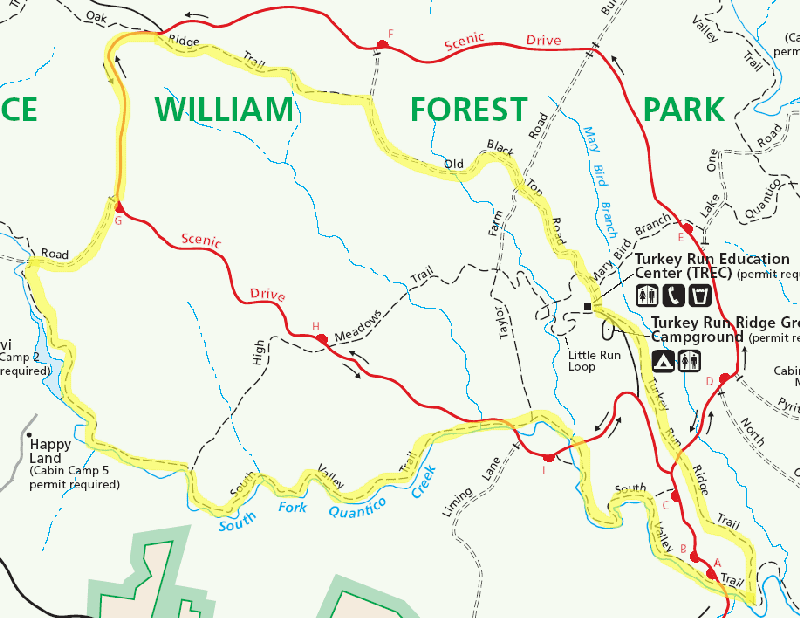
1 Jan 2008 — 31+ miles (~15 min/mi) — New Year's Day finds me jogging and walking along some beautiful terrain in Prince William Forest Park; I would run there every day if it weren't 50 miles from home. Today's race [2] is another VHTRC "Fat Ass" event, free and with no prizes. After a 1-mile circuit the course repeats a 10-mile loop three times, beginning and ending at the Turkey Run Education Center (TREC). Black blazes mark the Turkey Run Ridge Trail, which leads to the South Fork Quantico Creek where the white-blazed South Valley Trail wends its way upstream for 4-5 miles. A gravel road then climbs to the unmanned aid station near the paved Scenic Drive, which in turn takes runners to yellow-blazed Oak Ridge Trail and then the gravel Old Black Top Road back to TREC. A major start/finish aid station is thus seen at miles 1, 11, 21, and the finish.
Today is a day of sounds: wind in the treetops as the cold front comes through, half-blown-down trees creaking against their neighbors as they prepare to finish falling, water in the streams splashing as it flows over rocks, and so forth. The weather is cool, near freezing when we start at 7:30am, half an hour before the "official" time. No worries --- we can do whatever we want!
Race founder Bill Sublett leads Lou Jones and me along the 1-mile prelude in about 15 minutes. He gets us a couple of miles into the main loop before trotting on ahead. Lou and I chat as we journey. Some decades ago he worked in the field of geodesy, the science of the Earth's shape. So we have what perhaps is one of the strangest conversations to be held in the woods, concerning ellipsoidal figures of equilibrium, spherical harmonics, the Chandler wobble of the Earth's axis, etc. Neat-o! Lou has run some hundred-milers and I ask him about his experiences in training for them.
I carry two bottles of electrolyte drink, and share energy gels and electrolyte capsules with Lou. Near mile 10 we join up with a couple of other runners who tell us funny stories; one says he is famous for his recipe for inducing vomiting: wash down a gel packet with a fizzy coke. We finish our first loop together at ~16 min/mi pace (in 2:42), and after refueling and reentering the forest I trot on ahead of Lou. My second lap is uneventful until near its end when a blazingly fast runner comes up behind me and passes me. It's Howard Nippert, legendary ultramarathoner! He's 10 full miles ahead of me, and wins the race in 4:38. He's also friendly and helpful; I chat with him when I arrive at the aid station (my second loop takes 2:28). Race Director Gary Knipling takes our photo with my cellphone camera. Then it's onward for me again, into my last 10 mile loop.
Ooof! is the sound I make at my first and only major stumble, near mile 28. I trip on a rock and land flat on my chest, knocking the wind out of me and scraping arms and knees. Fortunately I fall onto a smooth patch of dirt; my face and other unimportant body parts aren't injured. The last circuit takes me 2:29 and so my total time is 7:54 — 12th place! That accomplishment is put in proper perspective, however, by the fact that there are only 13 finishers of the 50k. (Roughly 33 runners do shorter distances.) Bill Sublett is 9 minutes ahead of me, and Lou Jones comes in somewhat later. I'm lucky that there weren't more aid stations, since I spend 5-10 minutes in each one that I encounter. A few photos from the race are posted on [3]; the official results are at [4].
Overall the Red Eye 50k is a wonderful experience for me. Many thanks to all the organizers and volunteers who helped make it happen!
Al Lewis 10 Miler
5 Jan 2007 — 10 miles (12.1 min/mi) — Ken Swab's friend Kenny Ames meets me at the Forest Glen Metro station and I give him a ride to today's DCRRC race. A herd of half a dozen deer emerge from the suburban brush to stare at us as we cruise along Beach Dr on our way to Ken-Gar. Christina Caravoulias drives past just as I return to the car to get my entry fee; I'm walking along holding a $5 bill in my mouth while I put away the key. I register and then meet Chris on the path. In the clubhouse before the start she introduces me to several folks, including Washington Post running columnist Jim Hage and his lovely wife. (They're expecting twins and I can't resist telling stories about our twins.)
The temperature is in the mid-20's as we line up at 9am. Chris and I take photos of each other with my cellphone camera (see [5]) and then we're off. The course goes from Ken-Gar downstream on Rock Creek Trail to Old Spring Road where it angles uphill on neighborhood streets to the 5-mile turnaround. Police cars with flashing lights protect us at the major road-trail intersections, though at one point late in the race a huge peleton of cyclists blasts in front of us as we're about to cross Beach Drive. During mile 6 I announce that I'm feeling a sudden craving for peanut M&M candies. Chris kindly gives me a packet of orange sports beans which shuts me up and keeps me happy.
It's a fine race, especially in comparison to last year's event that featured meltdown temperatures in the 70s and relative humidity near 70%. Outbound our pace averages 11.9 min/mi but we slow a bit during the return trip and finish in a bit over 2:01, with Christina in 109th place and me 110th, dead last.
(cf. Jfk 2007 Preparation (26 Oct 2007), Potomac Heritage 50k 2007 (4 Nov 2007), Grapevine Run (12 Nov 2007), Don Quixote 55k Run 2007 (22 Nov 2007), Hunting Season (30 Nov 2007), Fallen Angel (8 Dec 2007), Lightning Crashes (23 Dec 2007), ...)
- Saturday, January 05, 2008 at 22:46:21 (EST)
Instead of New Year's Resolutions — a dangerous and generally unproductive enterprise — Merle Sneed, whose thoughtful online journal [1] I often enjoy reading, turns the cliché upside-down in a post last week which begins:
What I do like to do at the end of the year is to take stock of how it went, as years go. All I ever hope for the new year is that it will be a bit better than the last. That is subjective and partially out of my control, but a guy can hope.
After counting his immediate family blessings Mr. Sneed offers a list of other things that he looks back upon with some gratitude. Among the ones that I personally would like to be able to achieve:
Merle's bottom line:
All in all, 2007 wasn't perfect, but it was pretty good.
... a happy evaluation which reminds me of the Optimist Creed — yet another noble set of attitudes that I need to strive toward.
- Thursday, January 03, 2008 at 21:07:53 (EST)
Long ago I read (probably ~1970 in Analog, a science-fiction magazine which also published semi-scientific essays and articles and commentary) a claim: that "Hindu meditation" involves detaching one's mind from stimuli in the surrounding world, but that in contrast "Buddhist meditation" keeps the connection with the world but lets go of events immediately after they are perceived. Thus, supposedly, a Hindu adept hooked to an EEG would show no change if a sudden loud noise occurred, whereas a similarly-mindful Buddhist's brain waves would react and then immediately return to the calm resting state.
True? Myth? Gross oversimplification? Or irrelevant to meditative practice? I have no idea! But the general theme of Hinduism v. Buddhism reminds me of something else I read long ago: the 1967 fantasy/sf novel Lord of Light by Roger Zelazny. It begins:
His followers called him Mahasamatman and said he was a god. He preferred to drop the Maha- and the -atman, however, and called himself Sam. He never claimed to be a god, but then he never claimed not to be a god.
... and goes on to tell an at-times humorous story of a power struggle on a world in which technology mixes with Eastern religious imagery ...
(cf. Engineering Enlightenment (9 Oct 1999), Eat The Orange (28 Nov 2004), ...)
- Tuesday, January 01, 2008 at 04:19:15 (EST)
In a note a few weeks ago perceptive Caren correctly diagnoses my disease: I love to run with the ladies! The pattern is obvious ... ultramarathons with Amanda, Caren, Mary, Ruth ... memorable long-distance treks and training runs with Betty, Christina, Dina ... shorter excursions with various impromptu acquaintances of the fairer sex. Reasons are multiple:
And finally, I have a selfish motive:
- Sunday, December 30, 2007 at 20:20:15 (EST)
| I received the fundamentals of my education in school, but that was not enough. My real education, the superstructure, the details, the true architecture, I got out of the public library. For an impoverished child whose family could not afford to buy books, the library was the open door to wonder and achievement, and I can never be sufficiently grateful that I had the wit to charge through that door and make the most of it.
Now, when I read constantly about the way in which library funds are being cut and cut, I can only think that the door is closing and that American society has found one more way to destroy itself. |
(from Chapter 8, "Library", of I. Asimov: A Memoir by Isaac Asimov; cf. Boston Public Library (20 Jun 2002), ...)
- Friday, December 28, 2007 at 21:43:39 (EST)
To get the Oddmuse wiki up and running on 25 Dec 2007:
#!/usr/bin/perl package OddMuse; $DataDir = '/Library/WebServer/Oddmuse'; do 'current';
mkdir /Library/WebServer/Oddmuse chmod 777 //Library/WebServer/Oddmuse
package OddMuse; $SiteName = "ZhurnalyWiki"; $StyleSheetPage = 'ZhurnalyWikiStyleSheet'; $LogoUrl = '/images/zh.gif'; $CommentsPrefix = 'Comments_on_'; $AdminPass ='****';
with the Admin password whatever it is now set to (!)
push(@MyRules, \&BlockQuoteRule);
sub BlockQuoteRule {
# indented text using : with the option of spanning multiple text paragraphs (but not lists etc).
if (InElement('blockquote') && m/\G(\s*\n)+:[ \t]*/cog) {
return CloseHtmlEnvironmentUntil('blockquote') . AddHtmlEnvironment('p');
} elsif ($bol && m/\G(\s*\n)*:[ \t]*/cog) {
return CloseHtmlEnvironments() . AddHtmlEnvironment('blockquote') . AddHtmlEnvironment('p');
}
return undef;
}
- Thursday, December 27, 2007 at 05:43:39 (EST)
Maybe the movie is great (I haven't seen it) but the book Wuthering Heights by Emily Brontë is a mass of fears, plot-device births and deaths, class-consciousness, cartoon evil, and incomprehensibly irrational love. The people all speak in one voice, disguised in some cases by a veneer of heavy dialect. The author crosses her characters to produce convenient heirs as if she's breeding dogs or pigeons. Presumably there's some redeeming artistic merit in there — but it must be on a wavelength I'm colorblind to. Sorry, Emily.
- Wednesday, December 26, 2007 at 19:30:50 (EST)
The 2007 web edition of the Dickerson-Zimmermann family bulletin:
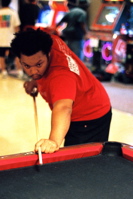 |
Merle continues as a grad student in Computational Chemistry but his big accomplishment this year was to reenter the world of tournament chess. He placed fourth in his first bout and was remembered by the tournament director as the baby in the Snugli on his dad's back at chess tournaments more than 20 years ago. |
| Gray is approaching graduation using a mathematical algorithm which graphs as an asymptotic curve. While she is in a slightly flat area right now, we believe she may be close to reaching the point where the curve races upwards. | 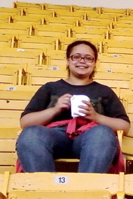 |
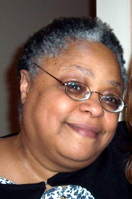 |
Paulette has all but given up most of the other work she used to do for the rôles of wall and window cleaner, spackler, sander, room painter and interior decorator. Her color choices have shocked and ignited members of the design community all over the world — of Silver Spring and Kensington Maryland, that is. |
| Mark has maintained his stellar running record of finishing 9th of 10 in his age group, 109th out of 110 in his last outing; he has run at least one race as a woman, one as a different man, and a third as a donkey (named Don Quixote). | 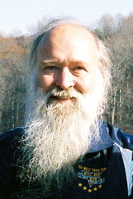 |
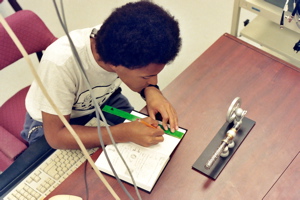 |
Robin graduated this past spring from the University of Maryland, College Park but he is also still there. He is now a master's student in mechanical engineering; his project is actually thermoacoustic engines which generate sound energy out of a heat difference the study of which combines the mathematical arcana of three engineering disciplines into one. |
| Due to the untimely death of Flopsy Bunny, the Dickerson-Zimmermann household is gradually losing the ability to coo and gurgle randomly, to ask "How's my little stinkums?", and to respond instantly to the ringing of bells. May she rest in peace. |  |
(newsletter by Paulette; cf. Dickerson Zimmermann 2002 (11 Feb 2003), Dickerson Zimmermann 2003 (18 Dec 2003), Dickerson Zimmermann 2004 Flip Side (22 Dec 2004), Dickerson Zimmermann 2004 (23 Dec 2004), Dickerson Zimmermann 2005 (24 Dec 2005), Dickerson Zimmermann 2005 Flip Side (24 Dec 2005), Dickerson Zimmermann 2006 (23 Dec 2006), ...)
- Tuesday, December 25, 2007 at 01:23:55 (EST)
I'm always a sucker for lists, and for Self Improvement advice. Combine the two and you've got me in nirvana! Gretchen Rubin in her "Twelve Tips to Avoid Seeming Like an Arrogant, Know-It-All Jerk" [1] of 19 Dec 2007 provides excellent suggestions. In brief:
1. Offer meaningful compliments
2. Give credit to others
3. Ask questions and allow others to supply information
4. Admit error
5. Remember other people's names and the details of their lives
6. Call on others for their specific contributions
7. Laugh at yourself
8. Refuse to take offense
9. Teasing
10. Remember your limits
11. Don't be a bore
12. Be courteous to others, no matter who they are
Of the assortment my big favorites are numbers 7, 8, 10, and 12. I gently disagree with #9 and find several of the rest redundant, trivial, or too office-centric. Nevertheless, the list is a good start. In expanding on #12, Ms. Rubin notes, "William Lyon Phelps wrote, 'The final test of a gentleman is his respect for those who can be of no possible service to him.'" — which brings to mind the inimitable Cardinal Newman "Definition of a Gentleman".
- Monday, December 24, 2007 at 18:38:05 (EST)
Although I never run with headphones/MP3 player I can understand how the companionship of music could help folks enjoy their exercise more. As I drive to the track before speedwork on 21 December, for instance, the car radio chances to play "Lightning Crashes" by Live. Fragments pace me as I sprint down the straightaways:
I can feel it coming back again Like a rolling thunder chasing the wind Forces moving from the center of the earth I guess I can feel it
Ten half-mile intervals glide by far faster than anticipated. Notes on that jogging experience, and others, follow.
DCRRC Bread Run
9 Dec 2007 — 2 miles (~11 min/mi) & 6+ miles (~13 min/mi) — Friend Christina Caravoulias recruits me to accompany her this Sunday morning in an old event that's new to me. Bob Thurston and Delabian Rice-Thurston of the DC Road Runners have for many years directed a "bread run": bring a loaf of homemade bread and the race is free. How can I resist? On Saturday I dust off the bread machine and produce a couple of loaves. The better one is my donation.
It's a cool, damp day when we arrive at Glen Echo Park. Before the 10k official event there's a 2 mile fun run which Chris suggests doing as a warmup; we return from the out-and-back course just in time for the start of the 10k main event. That course is a nice loop which includes a pretty stretch of C&O Canal towpath. Chris and I slow down to enjoy it and finish almost last. Afterwards winners get their prizes — bread — and then names are drawn at random to give away the rest of the food. I go home with two loaves, one for myself plus one that Christina gives to me. Tnx!
Magnus Gluteus Maximus Minimus
15 Dec 2007 — 10+ miles (~15 min/mi)— At dawn "No Rain" by Blind Melon is on the radio as I drive to Hemlock Overlook State Park near Clifton VA for a "Fat Ass" expedition on the Bull Run Trail. Throughout the morning garbled bits of "No Rain" lyrics ring inside my head: "All I can say is that my life is pretty plain / I like watchin' the puddles gather rain" and "So stay with me and I'll have it made...".
At my invitation a couple of friends, Kabrena and Kevin, have come to check out trail running, a new experience for both of them. Comrades Caren Jew and Mary Ewell are here too, as are a host of friendly members of the Virginia Happy Trails Running Club. At 8am we line up outside the lodge for a group photo, then set off, chatting and trying to avoid tripping on roots and rocks hidden under the leaves that blanket the path. The forecast for later today includes ice and snow, but the morning is cool, dry, and gray.
Our pace for the first 5-6 miles is a comfortable ~14 min/mi, which brings us to the Bull Run Marina aid station in about 1 hour 20 minutes. After food and photography Caren and Mary head out to pile on more distance. Caren finishes the day with something close to 22 miles, and Mary does only slightly fewer. I must get home early to attend a family friend's wedding, so Kabrena and Kevin and I turn back at the Marina. We average a relaxed ~16 min/mi during the return trip, walking the hills and enjoying the woodland scenery. It's a rather harsh introduction to trail running: Kevin falls down twice, and Kabrena turns an ankle three or four times. But both survive the experience and claim to have had a good time overall.
Jingle Bell Jog 8k
16 Dec 2007 — 5- miles (~11.3 min/mi) — A bright flash of light startles Christina and me as we reach her car after the end of today's MCRRC race. I assume it's a local electrical spark until, seconds later, a rumble of thunder arrives, soon followed by frigid rain. Today's event is uneventful: we jog together to finish not-quite-last in our respective cohorts. Chris gets momentarily miffed at me when one too many fellow runners pass us and I fail to object. I seem to have lost my competitiveness, if I ever had any. Sorry, Ma'am!
Lunatickle
19 Dec 2007 — 5+ miles (~10 min/mi) — "I'm being followed by a moon shadow" cycles through my mind as soon as I glance down and see a shady silhouette pacing me. The clouds part to let a gibbous orb peek out, and the sudden brightening makes me think someone is coming up behind me with a spotlight. A big tree has fallen across the path near the Audubon Society side-trail, making a waist-high hurdle to clamber over. Just past the Rock Creek Trestle a rustling in the brush startles me and I shine my flashlight on a fellow night stalker. "Hi deer!" I say.
Tonight's night run is penance for a pig-out at lunch: onion rings, salty french fries, and greasy veggie-burger. To push "Moonshadow" out of my noggin I start the song "Peace Train" chugging along. From home my path leads me by the new housing development at the old Seminary where a young gentleman in fancy clothes and carrying a bouquet of flowers emerges from a townhouse to be startled by my ugly mug. Tripping down Ireland Drive I focus on not tripping. Then it's sprint (slowly) up the far side of the hill, counting bridges over the stream: 1-2-3-4 ... stop, touch the fence at the security gate (no audible alarms), then zoom down 4-3-2-1 over the same bridges. Twinges come and go in right angle tendons, then left metatarsals. I accelerate along RCT to do a 9:20 mile, all running and all good. The new wooden bridge over Rock Creek is in place, wide and solid. Following the MitP route along East-West Hwy to Jones Mill Rd and Coquelin Terr takes me home on the CCT with a final 9:47 mile.
Kehoe 800s
21 Dec 2007 — 6+ miles (avg ~9 min/mi) — Marathon Deli in College Park is closing at 4pm for the holidays, and this is the last chance for the next eleven days to pick up gyros, souvlaki, and baklava for the family. Sons Robin and Merle are working in their labs on campus. I get home from work early on Friday afternoon, don running clothes, and head for UM. Temperatures are in the mid-40s and the northeast wind feels brisk. The gate to Kehoe Track is wide open even though a sign says that it's closed for "wind damage", none of which is evident.
Today is speedwork, Yasso 800s, though since I follow Lane 2 they're more like 808s. Cool weather and warm fantasies push me through ten 800m intervals at 4:23 + 4:17 + 4:12 + 4:06 + 4:14 + 4:09 + 4:09 + 4:09 + 4:01 + 3:51 — those last two done with great euphoria. Half-lap walk/jog breaks between each interval average a few seconds under 2 minutes each. Overall my average 800m time is 4:09, ridiculously faster than I have any right to do. Perhaps my training is finally taking effect, or maybe it's the music, "Lightning Crashes", tumbling about inside my head? "The angel opens her eyes ...".
Paint Branch and Indian Creek
22 Dec 2007 — 5+ miles (~10 min/mi) — Son Robin and I go shopping for last-minute gifts at the thrift store, then park at UM where he goes to work in the lab and I commence jogging. It's another faster-than-expected journey, today down Paint Branch Trail from mile marker 1.5 to 0, up Indian Creek Trail to its terminus, then reverse course. Squirrels scurry from my fearsome approach. Ducks dot the surface of Lake Artemesia for my outbound journey but only one remains half an hour later as I return. Miles flow by: 10:09 + 10:25 + 9:56 + 9:39 + 8:21 (!) not including a fraction to the Indian Creek turnaround in Berwyn Heights. Pain in the left metatarsals fades during the run; let's hope it doesn't come back.
(cf. Gunpowder Keg Fat Ass 2007 (24 Sep 2007), Mather Gorge (9 Oct 2007), Jfk 2007 Preparation (26 Oct 2007), Potomac Heritage 50k 2007 (4 Nov 2007), Grapevine Run (12 Nov 2007), Don Quixote 55k Run 2007 (22 Nov 2007), Hunting Season (30 Nov 2007), Fallen Angel (8 Dec 2007), ...)
- Sunday, December 23, 2007 at 20:55:13 (EST)
Gene Cowan writes thoughtful commentary [1] that I sporadically follow. (We met a couple of years ago, virtually, because of our common interest in Dc Boundary Stones.) Last month Gene was tuned in to a network TV show and observed:
We're now watching commercials WHILE the show is playing — not just promos, logos, and the like, but actual ADS moving around the screen. And yet I wonder, when will I simply turn it off, disconnect the satellite, and stop watching?
It reminds me of a scene in the 1983 movie War Games, when a self-aware AI computer simulates the results of global thermonuclear warfare and concludes:
A strange game. The only winning move is not to play. How about a nice game of chess?
That's how I feel about a lot of advertisement-supported media, including increasingly-large swaths of the Internet. "Support" has grown like a cancer and overwhelms content. Email and wiki spaces are spam pits. In many cases it's no longer worth the time and trouble to scroll past the trash. The only winning move is not to play. How about a nice game of chess?
(cf. For Themselves (8 Jun 2003), Gaming The System (17 May 2004), This Space Not For Rent (19 Dec 2004), No Ads (17 May 2005), ...)
- Friday, December 21, 2007 at 06:04:03 (EST)
| The main goal — which is the goal of graduate school — is not to learn everything, but rather to learn how to find out what you don't already know. |
(comment during a class by Howard Longyear ...)
- Thursday, December 20, 2007 at 05:33:10 (EST)
A few days ago I got confused — a not-uncommon state for me — about the distinction between conflate and confound. Apparently my mind had conflated (merged) the two words and I was thus confounded (mixed up). Then yesterday by chance I learned a new word: treva, the obscure diacritical mark placed above a vowel to indicate that it should be pronounced independently from its predecessor, as in naïve or coöperate. A treva is also called a diaeresis — another exotic new-to-me word meaning "separation".
The treva looks identical to the pair of little dots that make a German umlaut. For my whole life I've been conflating those two symbols!
(cf. Physics Words (22 Oct 2001), Fascinating Words (2 Dec 2001), Later Dude (14 Oct 2002), Prostrate Organism (9 Sep 2003), Voiced Postalveolar Fricative (27 Sep 2003), Rubensesque Passers By (24 Jul 2004), ...)
- Tuesday, December 18, 2007 at 19:06:11 (EST)
From The Power of Ethical Management by Norman Vincent Peale and Kenneth Blanchard, five "principles of ethical power":
(cf. Optimist Creed (16 Apr 1999), ...)
- Sunday, December 16, 2007 at 21:08:48 (EST)
| It's not how much you know, but what you can think of at the time that counts! |
(from comrade Carlos A's collection of aphorisms)
- Friday, December 14, 2007 at 20:47:30 (EST)
Mathematical popularizations — general-audience treatments of advanced math topics, or materials related to them — were among my favorite readings when I was growing up. Martin Gardner's columns in Scientific American were tops, but in the anthology of math-related short stories department I still remember Clifton Fadiman's Fantasia Mathematica (1958) and The Mathematical Magpie (1962). Recently I discovered that the late Mr. Fadiman's daughter Anne is herself a sprightly essayist. Her latest collection, At Large and At Small: Confessions of a Literary Hedonist, includes a sparkling piece on coffee that observes:
... At my home in Los Angeles, the coffee-making process had taken about three seconds: you plunked a spoonful of Taster's Choice freeze-dried crystals in a cup, added hot water, and stirred. With Peter's cafetière à piston, you could easily squander a couple of hours on the business of assembling, heating, brewing, pouring, drinking, disassembling, and cleaning (not to mention talking), all the while telling yourself that you weren't really procrastinating, because as soon as you were fully caffeinated you would be able to study like a fiend. The cafetière had seven parts: a cylindrical glass beaker; a four-footed metal frame; a chrome lid impaled through its center by a plunger rod topped with a spherical black knob; and three metal filtration discs that screwed onto the tip of the plunger in a sequence for whose mastery our high SAT scores had somehow failed to equip us. ...
(cf. The Guardian 23 Nov 2007 [1] as well as Bookhouse Boy (29 Sep 1999), Gateways To Mathematics (20 May 2004), Scientific American (11 Sep 2004), ...)
- Wednesday, December 12, 2007 at 17:44:21 (EST)
In a reminiscence about his younger sister Marcia, Isaac Asimov observes:
| Now here's a funny thing. Marcia remembers that I taught her to like Gilbert and Sullivan and that I had friends in the science fiction world who were interesting and witty, but she doesn't remember that we ever fought. She pictures an idyllic existence between us and I have found this to be true of other people who have shared memories with me. They wipe out whole continents of fact and construct some fairy tale that never existed and insist that that's the way it was. Maybe it is more comfortable to create your own past, but I can't do it. I remember things too well — although I don't say that my own past is entirely immune to reconstruction. When I wrote my autobiography and consulted my diary, I was astonished at the things I had forgotten, as well as the things I remembered that weren't so. They were all matters of trivial detail, however. |
(from Chapter 4, "Marcia", of I. Asimov: A Memoir by Isaac Asimov; cf. Asimov On Happiness (7 Nov 2007), Isaac Asimov (28 Nov 2007), Asimov On Precocity (2 Dec 2002), ...)
- Monday, December 10, 2007 at 21:43:44 (EST)
At 6:45am the full moon floats like a balloon between traffic lights over Clopper Road. Caren is ahead of me, waiting in a church parking lot that she found during reconnaissance yesterday with her daughters. Seneca Creek State Park is closed to cars at this hour, but we want to get some mileage in along the Greenway Trail before today's road race. I cruise by and almost miss the turn, but Caren sees me and flashes her headlights. I park and we prepare to run. Temperatures are in the teens, but we strip off excess layers in anticipation of exercise-generated heat. We walk downhill through the tiny original section of the St. Rose of Lima Cemetery, where some graves date back more than a century and a half. Caren spies a stone angel, toppled from its base, and carefully sets it upright.
Further notes on that jogging experience and other pedestrian adventures of the past fortnight follow ...
Seneca Creek Odyssey and MCRRC Turkey Burnoff
24 Nov 2007 — 8+ miles (~15 min/mi) & 10 miles (12.4 min/mi) — From the cemetery Caren and I continue to the highway, and as the sun rises we pause for a gap in traffic, cross, and enter Seneca Creek State Park. Caren leads me down an orange-blazed path from the Visitors Center to the Greenway Trail. Downstream we trot, chatting about everything and nothing, admiring the scenery, marveling at how warm we feel in spite of the frigid morning air. Soon we're climbing back up from the creek, passing the side trail to the Chickadee picnic area and crossing the main park road where we'll be racing in a few hours. Caren points out a family of deer moving through the woods. As we enter the underpass beneath Great Seneca Highway a great Great Blue Heron glides by above the stream.
We cross Riffle Ford Road and marvel at the absence of the water pumping station that was here last year. A mile downstream I check my watch and see that we've been on the trail for an hour; it's time to turn back. We look around and find no landmarks, so at my suggestion we climb the hillside and enter an open meadow. Near 39.132N 77.282W we take photos of each other, including one of the best images I've ever snared: "Hunting Season", Caren standing en déhanchement as she examines a frozen plant.
That's when a mysterious voice asks us to move along so he can shoot some deer. Yes, Sir! We scramble downslope to the trail and retrace our path to our cars.
Now the park is officially open, so we drive in and register for the race. Caren has to go home early and opts for the 5 miler; I'm planning to try 10 with comrade Christina Caravoulias. I lose my cellphone and can't find it under the blanket of autumn leaves. Helpful Chris calls it half a dozen times for me, however, and soon someone locates it and turns it in to Race Director Lyman Jordan.
Caren has her MCRRC number pinned on her leg, for convenience in changing upper garments. An official complains that it's hard to read there. Caren expresses concern to me. "No, don't move it," I advise. "This is America — you can do whatever you want. Write the number on your middle finger and show it to them when you finish!" Caren doesn't go that far — but she stops worrying and enjoys the run. She's far ahead of me at the finish line and since it's well away from the midpoint cone of the 10 miler this year we don't get to see one another for the rest of the day.
Meanwhile Christina and I are trotting along at a steady pace of ~12 min/mi for our first five miles, a great recovery run for me after the Don Quixote 55k Run 2007 a week ago. Chris's training is mainly focused on strength and speed in shorter races, so today she declares walk breaks of 1 minute every 5. That yields a pace that works quite well for us both. We decelerate to ~13 min/mi for most of the second half, chat, cheer other runners nearby, and enjoy ourselves. I take a couple of photos with my newly-recovered cellphone as we pass Clopper Lake. My official time is 2:04:10, dead last in my age/sex group. It's a fine day!
Northwest Branch Tempo Run and Hill Work
28 Nov 2007 — 5+ miles (~9.5 min/mi) — "The track is closed, Sir; there's a men's soccer game today," the UM staffer tells me as I approach the gate of Ludwig Field where Kehoe Track is located. He's wearing a Boston Red Sox cap, but my attempt to flatter him with "Go Boston!" doesn't work. I've already lost four quarters feeding the parking meter in hopes of some speedwork, but today I have to look for my fun elsewhere.
So west on University Blvd I go, to Adelphi Manor Park where on 12 Sep 2007 I had a good jog along Northwest Branch Trail. (cf. "Oakview Hill Work" in Phone It In) Today I'm about 1 min/mi faster than I was then. Perhaps some of the training is having a small effect, or maybe it's the few pounds I've attempted to trim off, or the cooler weather? For whatever reason I'm able to maintain a sub-10 min/mi pace on the flats, and even after the steep gravel hill climb to Oakview Dr at the midpoint I manage a final sub-9 blitz. I've forgotten to wear a wristwatch this morning, so I time myself using the cellphone and counting seconds until I see the minute flip over. Later I learn that my phone has a built-in stopwatch function. Next time!
MCRRC Frozen Slopes 6k XC
1 Dec 2007 — ~3.75 miles (~10.4 min/mi) — Master sandbaggers Ken and Wayne greet me before today's club race on a new course around Lake Bernard Frank. Christina and Robin and I walked it a week ago, so I know what to expect: hills! The Meadowside Nature Center features some exceptionally cute babes today. I take cellphone pix of two, Kent and Anita's children Michael and Andy, while I admire Anita's new Nikon D40x camera. Kent is racing; Anita is the photographer.
Wayne is playing a deep double-sandbag gambit: he tells me that he feels great today and plans to run fast, knowing that I will disbelieve him, and thus will be even more suprised when he blasts away from me. (I wonder how much he is really keeping in reserve?) Ken takes it easy, recovering from his JFK 50 miler and other running in recent weeks. We jog together and banter for the first half mile; then I take the lead during a hill climb. At the aid station I pause to tie my shoe, then trot on across the dam that forms the southern end of the lake. Wayne blasts past as I approach the turnaround; he's already at least a minute ahead, and goes on to finish at an overall sub-10 min/mi average pace.
Ken is not far back of me when I see him after I make the turnaround. I slow a bit and have to walk some hills in the second half, but keep pushing and finish in 39:51 for — drum roll please — 6th out of 7 in my age/sex group, at an average 10:42 min/mi. I lie down on the ground near the finish line to catch my breath. Wayne observes, "For someone as pitifully slow as you are, you did pretty well today." Thanks, buddy!
PHT + C&O Loop
2 Dec 2007 — ~9 miles (~14 min/mi) — My phone rings at 8:30am as I'm driving across Chain Bridge over the Potomac River; I fumble and drop it on the floor. A few seconds later I pull into the Glebe Rd/41st St N parking lot and see Mary, early and wondering where I am. We leave her car and I drive us down the GW Parkway to Teddy Roosevelt Island where the Potomac Heritage Trail (PHT) begins. It's a chilly ~40°F with 5-10 mi/hr winds as a cold front approaches. Leaves cover the rocks and roots along the trail. Today's mission: get Mary's mojo back after the super-tough JFK 50 miler she ran last month!
On 27 Oct during the Potomac Heritage 50k 2007 I experienced this segment of the PHT and found it heavy going. Today the waters of the streams we must cross are lower and the ground is less muddy, but the leaves are just as slippery and the terrain is still rugged. But with Mary's company the distance goes by comfortably, and even the terrifying climb up the shear rock face at mile ~3.8 is not quite as daunting. Before we begin I warn Mary about the cliffs of insanity there, and she doesn't tease or laugh (too much) at my wimpishness. After ~4 miles and ~1:24, including time to powder our respective noses a few times along the way, we're back at Mary's car.
We refuel and cross Chain Bridge to the C&O Canal. A Great Blue Heron glides within a few feet of us beneath the Arizona Ave trestle. At Fletchers Boathouse we detour to view the tunnel under Canal Road that I found so frightening during the PHT50k; today it looks far milder. After ~26 minutes we're at C&O milepost 3. I remind Mary that she's been here before — only 55-80 miles up the river during the JFK and our training runs (cf. Jfk 2007 Preparation and Don Quixote 55k Run 2007). Today we both feel stronger, and on the board-flat towpath I challenge Mary to some speedwork. Our next mile is 11:25, but after that we slow to 13-14 min/mi pace as the wind rises and a chill drizzle begins. After spying another Great Blue Heron perched on a Georgetown wall we cross the Potomac on the Key Bridge and are back to my car after a total time of 2:25 for the 9+ mile circuit.
Mary fishes for sympathy by continuously bemoaning her slowness — I tease her back, reminding her of her recent JFK and today's brisk 11:25 mile. Both of us are chilled at the end of the run and, independently, get a case of the shivers in our respective cars on the way home. Both of us recover via hot showers. Apparently the body needs help to shift from running-metabolism to resting-metabolism.
Lake Artemesia Orbits
7 Dec 2007 — ~15 miles (~10.5 min/mi) — A few inches of snow is melted and refrozen into icy patches along Paint Branch Trail (PBT) but most of the asphalt is clear. After an 16-hour fast for a cholesterol blood test (which turns out ok, thank goodness) I snarf down a Clif Bar and a can of Cherry Coke, drive the kids to the University of Maryland, and set off a little before 10am. My original thought was to do some speedwork around Kehoe Track, but the gates are locked.
So Paint Branch to Lake Artemesia it is. Temperatures are in the low 30's and intermittent light sleet or drizzle patters down — near-perfect weather for someone whose engine runs as hot as mine. At the end of the first measured PBT mile (markers 1.5 to 0.5) my watch says 10:40, which seems too fast to me but feels strangely comfortable.
Three big geese lumber into the air and fly overhead, honking their welcome as I go under the train tracks and enter Lake Artemesia Natural Area. At first I have the place all to myself except for hundreds of ducks, squirrels, sparrows, wrens, and unseen wildlife. The ice is slippery along the windward southern edge of the park but the rest of the pathway is clear. I jog around to the start/finish of the 1.35 mile Lake Loop. Without any walking I still feel good when I reach the 1 mile mark painted on the pavement, so I take a split and do it again. And again. And again.
A frigid flock of birdwatchers arrive and then flit away. On a hot and humid 12 May 2007 expedition I did three laps around Lake Artemesia (cf. "My Goose is Cooked" in Trail Improvement) and suffered. Today seems effortless in contrast, as the miles flow by at a consistent 10:33 + 10:28 + 10:30 + 10:28 + 10:29 + 10:35 + 10:28. I think about stopping after six loops when my left hip begins to ache a bit, but except for twinges in the left metatarsal area I'm still feeling solid, so I press onward to nine.
A heavily-bundled lady jogger with a big bouncy blonde ponytail appears and vanishes. Real, or illusion? My mental math says that every orbit is about 4/3rds of a mile, so I want to do a multiple of three including entry/exit laps. And there are ~1.5 miles each way between where I left the car and the Lake. A young Asian fellow begins to circle the lake clockwise, and I nod at him him twice per revolution as we pass in opposite orbits. Green line Metro trains rattle by on the elevated tracks.
Cold crows scold me from a scrawny tree as I accelerate for a final Artemesia mile in 10:12. Overall average pace around the Lake Loop today, including 0.35 mile fractionals, comes to 10:28 min/mi. Amazingly fast for me, but it's cold, the course is nearly flat, and I'm been trying to lose some weight (I'm probably in the low-160s zone now) — all of which conspire to help make it my day. Too bad it's not a race!
After ~2 hours I've used up both bottles of Zelectrolyte Formula that I carry and it's definitely time to head back. The return trip on the Paint Branch Trail gives a mile time (between markers 0.5 and 1.5) of 10:26. And not one walk break today — wow!
(cf. Pied Beauty (27 Aug 2007), Phone It In (21 Sep 2007), Gunpowder Keg Fat Ass 2007 (24 Sep 2007), Mather Gorge (9 Oct 2007), Jfk 2007 Preparation (26 Oct 2007), Potomac Heritage 50k 2007 (4 Nov 2007), Grapevine Run (12 Nov 2007), Don Quixote 55k Run 2007 (22 Nov 2007), Hunting Season (30 Nov 2007), ...)
- Saturday, December 08, 2007 at 19:48:16 (EST)
A friend gave me some old issues of Outside magazine to read, and hidden between the advertisements I found a few entertaining articles. In particular, the September 2006 number contains a fine essay by Mark Jenkins titled "Infinite Sorrow" [1] about Sue Nott and Karen McNeill, mountaineers who vanished during a difficult climb of Mt. Foraker in Alaska. McNeill was an ice-climbing instructor at an all-women school in Colorado called "Chicks with Picks". My eye for lists was caught by:
... According to cofounder Kim Reynolds, a close friend of both women, McNeill had three rules: "First, you could never say you're sorry while climbing," recalls Reynolds. "Second, as Karen lowered you off a climb, she would stop and hold you one foot off the ground until you said, 'I am a goddess.' Third, after you got off the climb, you always had to state one thing you did well."
Roger on the first rule; I try to enforce a similar "I'm sorry" prohibition during long tough runs with friends, though usually without success. (I'm a frequent offender myself.) The third rule is an excellent one: it's always wise to look back and learn from challenging experiences.
But the "goddess" schtick? Alas, it reminds me too much of a scene in the excellent movie Almost Famous where Billy Crudup's severely-stoned character proclaims "I am a golden god!" before jumping off the roof of a house into a swimming pool ...
(cf. Check Your Mirrors (17 Sep 1999), Conflict Aversion (22 Feb 2000), Big Lessons (17 Feb 2001), ...)
- Thursday, December 06, 2007 at 22:18:48 (EST)
After a dinner of Chinese carry-out my daughter opens her fortune cookie and reads aloud, "You have a yearning for perfection." My wife hears it as:
This inspires some other suggestions around the table for Unfortune Cookies:
(cf. Gibbonomatic Requiem (15 Mar 2007), ...)
- Tuesday, December 04, 2007 at 21:02:32 (EST)
| If only an infant prodigy could be prodigious in grasping human nature and not in memory and quickness of intellect alone. But then, not everything is inborn. The truly important parts of life develop slowly with experience, and that person is lucky who can learn them more quickly and with greater ease than I did. |
(from Chapter 1, "Infant Prodigy?", of I. Asimov: A Memoir by Isaac Asimov; cf. Asimov On Happiness (7 Nov 2007), Isaac Asimov (28 Nov 2007), ...)
- Sunday, December 02, 2007 at 18:45:06 (EST)
For back issues of the ^zhurnal see Volumes v.01 (April-May 1999), v.02 (May-July 1999), v.03 (July-September 1999), v.04 (September-November 1999), v.05 (November 1999 - January 2000), v.06 (January-March 2000), v.07 (March-May 2000), v.08 (May-June 2000), v.09 (June-July 2000), v.10 (August-October 2000), v.11 (October-December 2000), v.12 (December 2000 - February 2001), v.13 (February-April 2001), v.14 (April-June 2001), 0.15 (June-August 2001), 0.16 (August-September 2001), 0.17 (September-November 2001), 0.18 (November-December 2001), 0.19 (December 2001 - February 2002), 0.20 (February-April 2002), 0.21 (April-May 2002), 0.22 (May-July 2002), 0.23 (July-September 2002), 0.24 (September-October 2002), 0.25 (October-November 2002), 0.26 (November 2002 - January 2003), 0.27 (January-February 2003), 0.28 (February-April 2003), 0.29 (April-June 2003), 0.30 (June-July 2003), 0.31 (July-September 2003), 0.32 (September-October 2003), 0.33 (October-November 2003), 0.34 (November 2003 - January 2004), 0.35 (January-February 2004), 0.36 (February-March 2004), 0.37 (March-April 2004), 0.38 (April-June 2004), 0.39 (June-July 2004), 0.40 (July-August 2004), 0.41 (August-September 2004), 0.42 (September-November 2004), 0.43 (November-December 2004), 0.44 (December 2004 - February 2005), 0.45 (February-March 2005), 0.46 (March-May 2005), 0.47 (May-June 2005), 0.48 (June-August 2005), 0.49 (August-September 2005), 0.50 (September-November 2005), 0.51 (November 2005 - January 2006), 0.52 (January-February 2006), 0.53 (February-April 2006), 0.54 (April-June 2006), 0.55 (June-July 2006), 0.56 (July-September 2006), 0.57 (September-November 2006), 0.58 (November-December 2006), 0.59 (December 2006 - February 2007), 0.60 (February-May 2007), 0.61 (April-May 2007), 0.62 (May-July 2007), 0.63 (July-September 2007), 0.64 (September-November 2007), 0.65 (November 2007 - January 2008), 0.66 (January-March 2008), 0.67 (March-April 2008), 0.68 (April-June 2008), 0.69 (July-August 2008), 0.70 (August-September 2008), 0.71 (September-October 2008), 0.72 (October-November 2008), ... Current Volume. Send comments and suggestions to z (at) his.com. Thank you! (Copyright © 1999-2007 by Mark Zimmermann.)